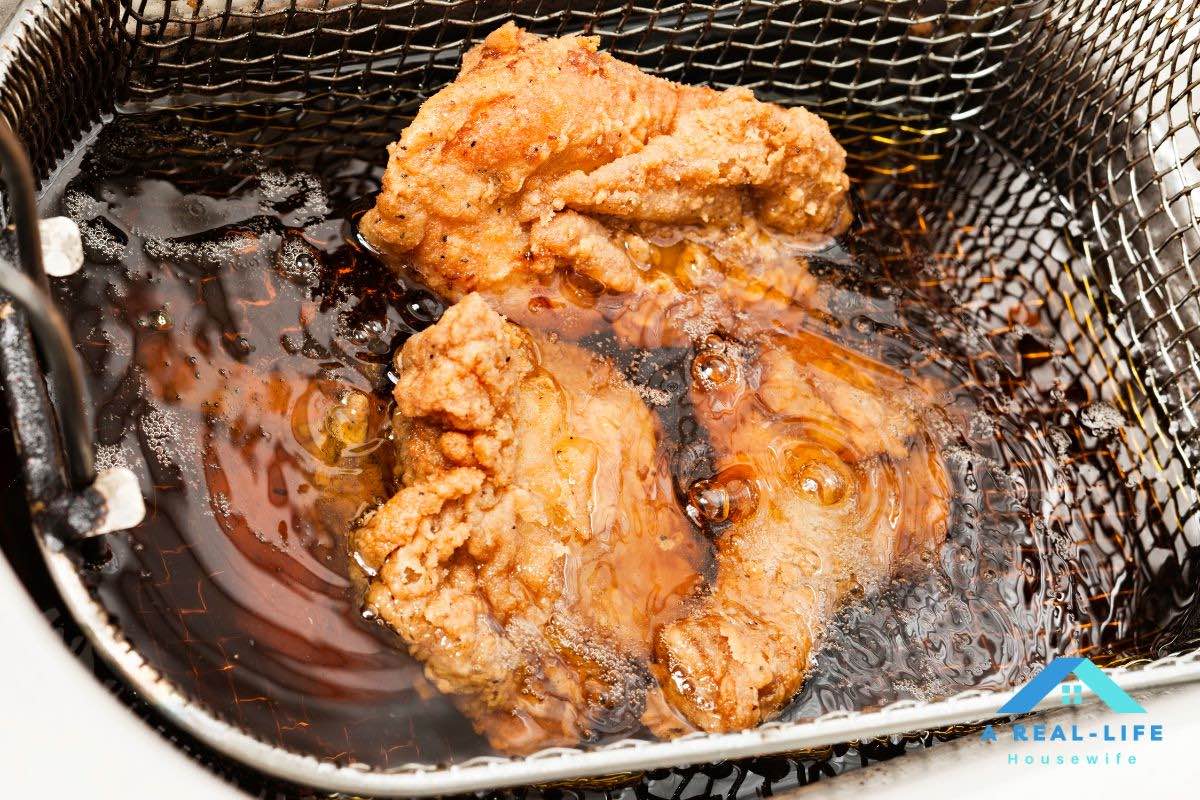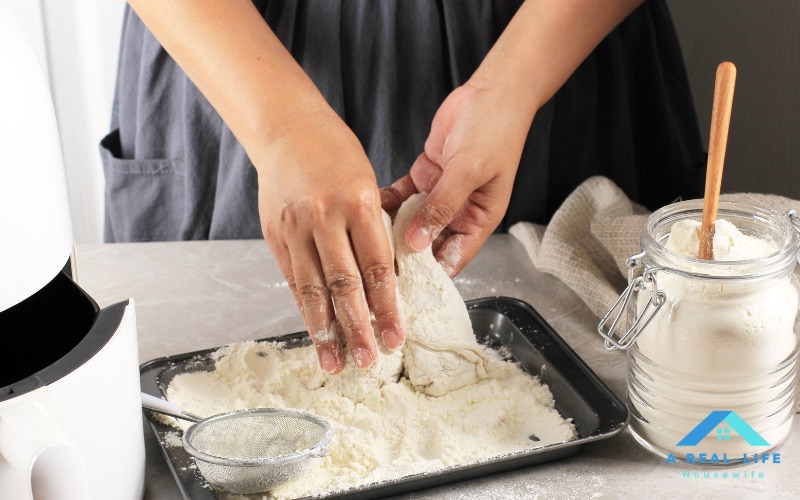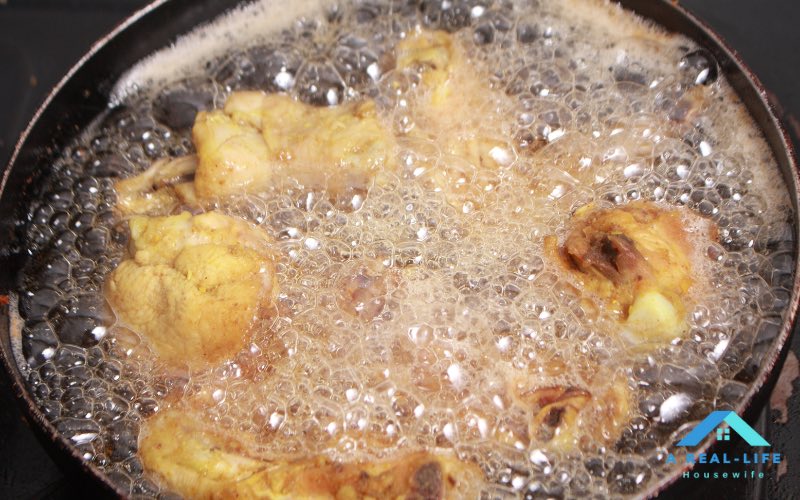Are you looking to fry up some chicken without flour? Yes, you can.

This is a common endeavor, as folks pay attention to the gluten, carbs, and calories in their food. Should you opt to go without breading, or to go with a low-calorie breading option like baking powder, you’ve got a lower-calorie meal that’s both delicious and kind to your waistline (and health). You might worry that it’s not possible to make good, crispy fried chicken without flour. Can you fry chicken without flour? Never fear! There are several flour replacements (and other types of breading) that will work just as well or better!
What You Will Need to Follow This Tutorial?
- Chicken
- Eggs (optional)
- Breading of your choice (optional)
- A deep pot or skillet
- Cutting board
- Seasoning
- Oil (canola, sesame, and corn oil are best)
Types of Breading to Replace Flour

There are so many different types of breading to choose from besides flour. Each has its own attributes and can uniquely alter the texture and flavor of your fried chicken – let’s take a look!
Cornstarch
Did you know, many Asian dishes use cornstarch as a replacement for flour? It’s used for fish, fowl, and other meats. While I’ve not tried it myself, I’ve heard that chicken fried in cornstarch is crispier. This is because, compared to flour, it holds onto less water. So, if you’re looking for a breading that will really crisp your fried chicken up, look no further!
Potato Starch
Potato starch is one of my favorite fried chicken breading replacements for flour. Potatoes are so hearty and savory, and they definitely add a satisfying chew to the fried chicken. What’s more, potatoes tend to hold onto a bit of moisture, so while the chicken is still crispy, it remains delightfully tender!
Baking Powder
Baking powder is another great flour replacement, when it comes to making fried chicken. In my opinion, it doesn’t taste quite as good as, say, potato starch or almond flour. It also doesn’t create as thick of a breading. However, due to its low moisture retention, it will ensure some truly crispy fried chicken. Just make sure to include plenty of seasonings for flavor!
Cornflakes
I’d had cornflakes on macaroni and potatoes, but I hadn’t on chicken. I really enjoy the crunchy texture that cornflakes add to food, so I decided to give it a try. It took me a couple of attempts to get the breading just right. I tried to do it without eggs, and it simply wasn’t possible. So, if you choose cornflakes as breading, you’ll probably want to include eggs as well. Because of the frying, the cornflakes become a bit softer and crispier, and the oil and seasonings bring out a surprisingly rich corn flavor. Who knew cornflakes were so useful in savory cooking? (If you like cornflakes, I definitely recommend giving this a try).
Bread Crumbs
Now we have a classic, bread crumbs. There’s very little by way of savory food that doesn’t go well with breadcrumbs. If you’d like to crisp your fried chicken up, this will certainly do the trick!
Substitute Flour
Can you fry chicken without flour? When it comes to an alternate breading for fried chicken, you can always go with a substitute flour. There are many of these available today, including almond flour, quinoa flour, rice flour, coconut flour, potato flour, and more. Personally, I’ve had the most success with almond flour – it has a delightfully fluffy texture and mild flavor that I think work superbly as a breading (especially when mixed with seasonings and oil). Potato flour is a bit thicker and mealier, but makes for a nice crunch. You can also mix any of these flours together in order to achieve the ideal texture (potato and almond flour, for example).
Step-By-Step Instructions

- Pick your chicken. Before you can get frying, you’ll want to pick up some chicken at the store or your local butcher shop. The most popular kinds of chicken for frying are drumsticks, wings, and chicken breasts. In my opinion, chicken breasts tend to be the most tender. Drumsticks, on the other hand, have lots of skin that will get nice and crispy (they’re also more affordable).
- The next step is up for some debate. Some folks think you should wash chicken, while others are opposed. Actually, washing chicken does very little to clean it, as it won’t eliminate any of the harmful bacteria (like salmonella). This takes heat (at least 145-165 degrees F). Moreover, the water gives the potentially harmful bacteria a chance to splash and travel. Personally, I don’t wash my chicken – it doesn’t seem particularly effective or necessary to me. This being said it’s your call!
- Preheat oil. Next, you’ll want to preheat your oil. Add a cup or two of the oil of your choice (enough to cover the chicken), and set on medium heat (ideally around 325 degrees F). In 7-10 minutes, your oil should be ready to go. Pro tip: to see if the oil is ready, you can dip a wooden spoon inside of it. If bubbles appear around the spoon, the oil is hot and ready to fry. You can also employ a food thermometer if you prefer! You’ll want the oil temperature to be roughly 325 F.
- Bread the chicken. Can you fry chicken without flour? Certainly. While the oil is preheating, it’s a good time to bread the chicken with your flour substitute. Of course, you can make fried chicken without any breading at all… but in my opinion, breading makes the chicken much crispier! In order to bread the chicken, you’ll need the breading of your choice (as listed above) and a cutting board. Many will also opt to use eggs, to help the breading stick (optional). Lay the chicken out on the cutting board and place a bowl of breading next to it. If you’re using eggs, you’ll want to pour them into their own little bowl and lightly beat them with a fork. You can dip the chicken in the eggs and then roll it in the breading, and the breading will stick more easily. You can also skip this step and roll the chicken right in the breading. Make sure that both sides of the chicken have a nice, even layer!
- Season the chicken. Once your chicken is breaded, it’s time to season it up. What seasonings are your favorite? Personally, I go for the classics: salt, pepper, paprika, rosemary, and basil. Sometimes I’ll also include some lemon or lemongrass, for a subtle burst of bright flavor! Feel free to be generous with the seasoning, as some of it will be lost in the oil.
- Once you’ve got your chicken all dressed and ready to fry, you can pop it in the deep pot or skillet of preheated oil. I recommend using a wooden spoon or other handy and heat-proof utensil to place the chicken in the oil. This will help to avoid any splashing or potential burns. I also recommend placing an oil screen on top of the pot or skillet, as this is generally a good idea when frying food. It will not only help prevent injury but keep the oil from making a mess around the pot or skillet as well. As a general rule, you’ll want to cook each piece of chicken for 8 minutes on each side. This will ensure it’s cooked through, and that it has reached the optimum crispiness. Of course, you can also play it by ear. Keep an eye on the chicken and make sure that it reaches a nice golden brown (any darker and the chicken will begin to dry).
- Drain excess oil. Once your chicken is fried up beautifully, you’ll want to take it out of the oil to cool. The chicken is sure to be quite oily, and this means that some paper towels are called for. Place the chicken on the paper towels for a few minutes, so they can absorb the excess oil. This will also give the chicken a chance to cool.
So, what did you think of this article? I sure hope it was helpful! Chicken is one of the most versatile meats, and fries up wonderfully, especially with the right breading (I’d have to say that wheat flour, potato starch, and almond flour are my favorite). Have you tried any of these flour alternatives? Which do you like best, and why? Feel free to comment your answer – I’d love to hear!
